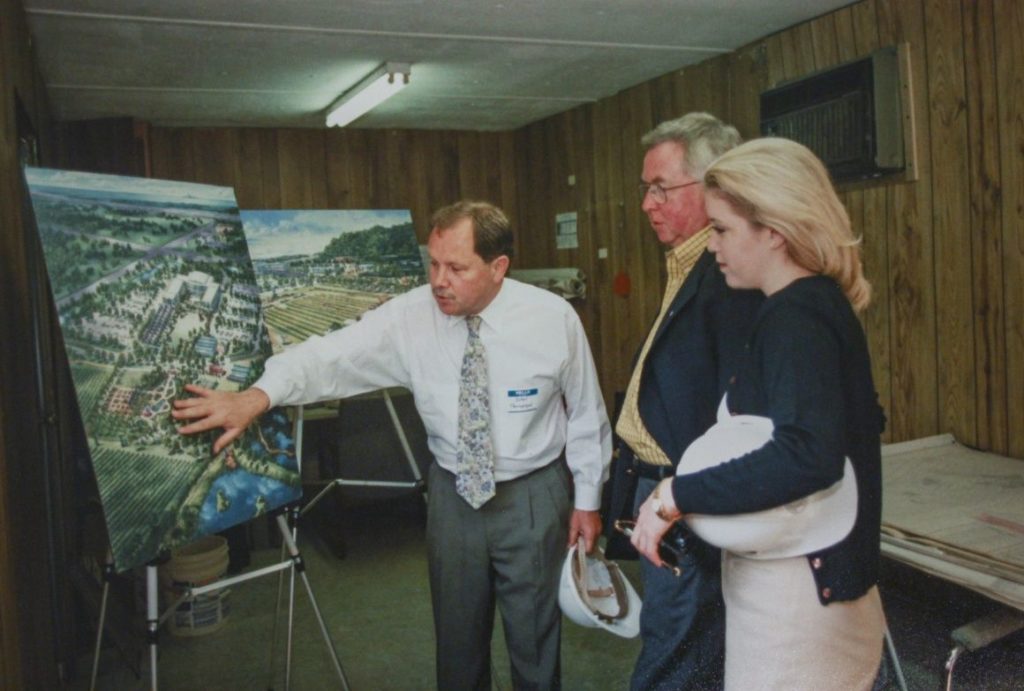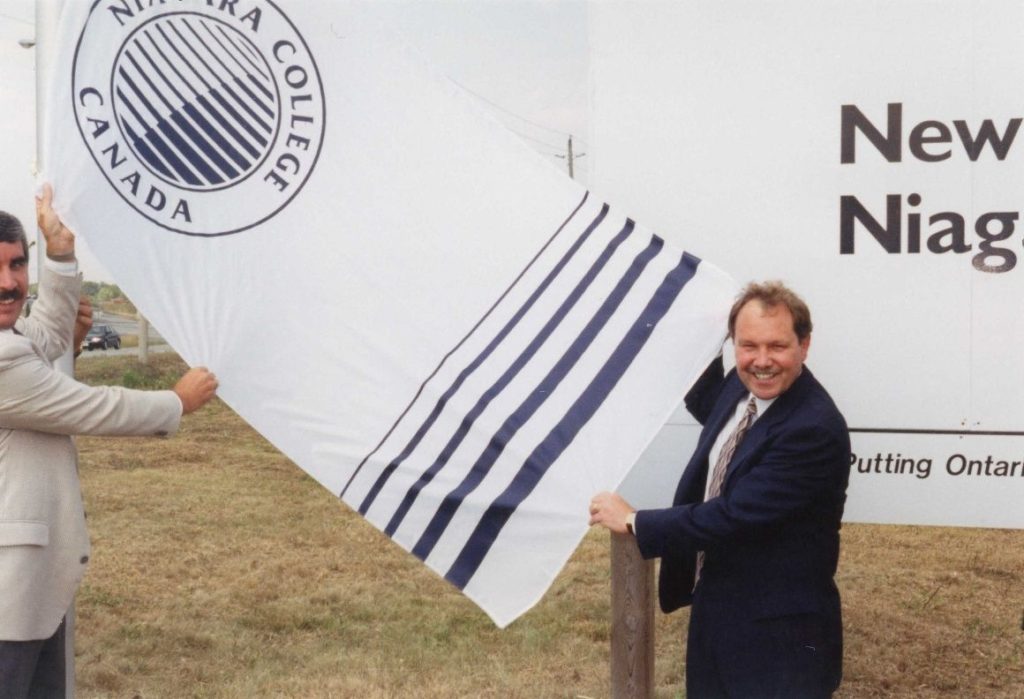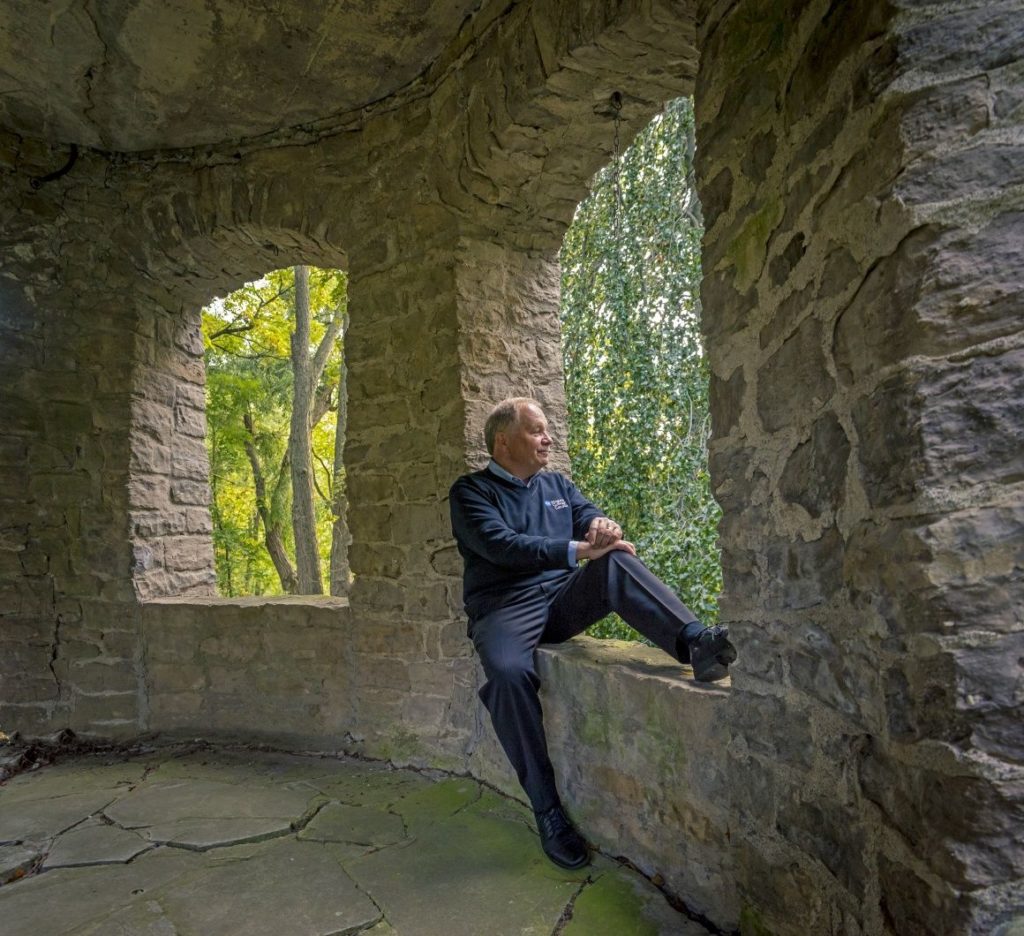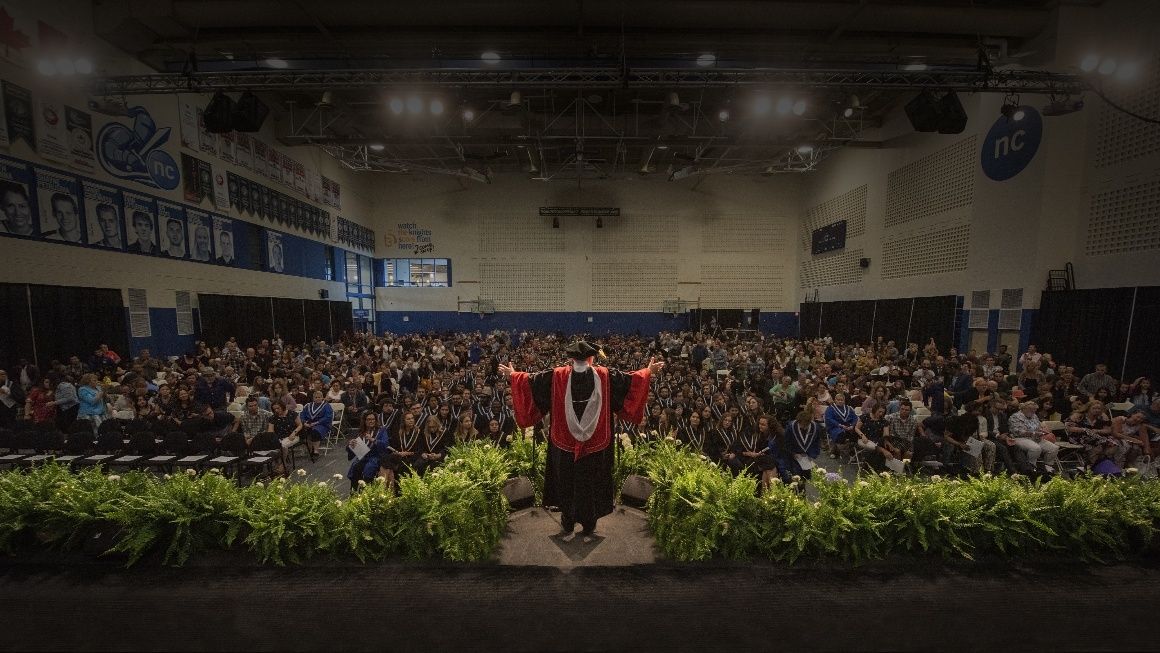In 25 years as the college’s leader, he saw the names of several local families and businesses affixed to newly constructed research labs, classrooms and other facilities as thanks to donors who believe in and support the college’s work to better Niagara.
But it would be just months before retiring in early 2020 as the College’s longest-running helmsman that Patterson would attend the most monumental dedication of them all. In November 2019, the College’s board of governors proclaimed the entire Niagara-on-the-Lake campus would be named for him, Daniel J. Patterson.
“It’s actually overwhelming,” Patterson said of the gesture. “My wife, (Saundra) who tells me everything, she knew about it and didn’t tell me because she knew the surprise would be so special. She was there through thick and thin. There was never a rumour ‘Oh, let’s name this after Dan.’ It really was a surprise and shock.”
And it may never have happened if Patterson didn’t have the tenacity to get that campus constructed in the first place, all the while building up the rest of the college alongside it as a beacon of innovation and a model for post-secondary institutions throughout Canada and the world.
The right person for the job
At the time, Niagara College languished as a bit of a last-chance high. It had “small, unassuming programming and it needed to get a reputation and a brand.” It also lacked strong connections to the community it intended to serve.
He was just the person to do it, too, coming from the Ministry of Skills Development with his finger on the proverbial pulse of how colleges elsewhere in the province were proving their relevance. Patterson had previously helped forge a partnership between Toyota’s Cambridge, Ont., operation and Conestoga College in Kitchener, so he had a track record of making things happen.
Patterson had started at the College a few years earlier as Vice President, Ventures – linking the College with the community, including employers, industry and government programs and projects.
“I realized that interface was really critical. My philosophy in building a college was to connect the classroom to the realities of life. I saw how powerful it was to connect a college to the community,” he said. “I came into the job with a strong economic development mission, knowing from my previous job that the value of colleges, which was underdeveloped, was the role colleges could play in economic development.”
During that time, Patterson got to know the region, the economic development departments of each municipality within it, and other key players. And through him, they got to know the college.
“I saw that if the College could be intricately woven into the economy of Niagara, it could have real-life programming and lead economic development,” he said.
A few years later Patterson found himself so intertwined with the community that it was a natural next step in his career to apply for the job of College president when it opened in 1995. He knew the who’s who of the region and he and Saundra had fallen in love with Niagara outside of his work.
While he seemed like a shoo-in for the role, the search for a candidate went national in scope. That year, though, Patterson was handed the reins for what would become the longest tenure of any Niagara College president. The following 25 years and accomplishments he’d clock would make Patterson a rarity among those running a college or university anywhere in Canada.
There was no resting on any laurels when he was selected for the job, however. Both Patterson and the College were in for some dark days early on.

A vision realized
The College was running a deficit and despite Patterson’s efforts in the years leading up to his new post, he recalled how those hallowed halls still lacked an MO. The college was also operating during an economic recession in a province with a newly elected government under Mike Harris that was determined to save money. It didn’t bode well for a school struggling to find itself.
“The College was very small, 2,500-3,000 students, and it didn’t have a strong raison d’être. It didn’t have a strong set of programs in the college system or provincially that was noted for differentiation and, therefore, it was vulnerable,” Patterson recalled.
Still, it did have a newly minted president determined to change that. But it would come with some tumult, starting with axing the largest program the College offered: nursing. It was one of many cuts Patterson would have to carry out.
The toughest blow came when the province declared it was broke and cancelled capital projects at community colleges. That included abandoning plans for the construction of Niagara College’s new campus on an 18-acre swath at Glendale Avenue and Taylor Road in Niagara-on-the-Lake.
That new campus wasn’t fat that could be cut from Patterson’s perspective. The College, which opened in 1967, was still largely operating out of temporary buildings, including a 19th-century factory near downtown St. Catharines.
“Our facilities were some of the worst in the college system. Here we were to get $35 million. It was devastating,” Patterson recalled.
There was only one thing to do: take Premier Harris on a campus tour.
“That’s where government relations took on a whole new meaning and there was advocacy to get the government to change. I put in all my efforts. It was an entire team effort,” Patterson said. “It was a turbulent time that required community engagement and tours to say students shouldn’t be going to a 19th century building like Welland Vale.”
It worked. When the province started to loosen its capital funding purse strings, the college got its money back to build a new campus. Everyone “hit the ground running” to make it happen quickly, and just before construction costs ballooned to near unfathomable levels.
The new campus, which opened in 1998, created conditions for opportunity and shaped a compelling vision for the College’s future. The College’s product development team could see more clearly what could be done with programming.
But again, Patterson and his colleagues at the college didn’t go it alone. They tapped into the community for input into the kind of training students needed. They also looked beyond Niagara for experts in their respective fields to teach the skills tomorrow’s workforce needed.
Whether it was training aspiring chefs to cook over a gas flame or future welders to use a flame cutter, the college under Patterson’s leadership created programs that would attract ambitious students and produce hireable graduates — world ready graduates — after a few years of study.
“In universities, they talk about faculty as a community of scholars. At a college, the faculty is a community of practitioners who bring their experience to the college and who bring their connections,” he explained.

Building an innovative college of firsts
Together, that community of practitioners established many firsts, including Canada’s inaugural teaching winery and visitor centre, which led to the creation of the unparalleled Canadian Food and Wine Institute. Niagara College became home to the country’s first professional brewmaster, distilling and commercial cannabis production programs, too.
Energy was also channelled into building applied research facilities where students and industry players could work together solving critical issues in agriculture, food product development and advanced manufacturing. All of it would happen in some of the most beautiful facilities and locations of any college in the country.
As a result, colleges the world over started to turn to Niagara for guidance in establishing their own programs to better communities and and entire nations in South America, Africa, the Caribbean, Southeast Asia and the Middle East.
“That’s education at its best — the human application of education to the realities of the world,” Patterson said. “As president, I had to keep an eye on the future and my feet on the ground about what we could and couldn’t do.”
It was an approach that didn’t just build resilience in the students who took a seat in a Niagara College classroom. It made Niagara College a respected education institution that became the first choice among high school graduates and those returning to school to advance their skills.
Enrolment swelled as prospective students cued into the vision of leadership and potential of a Niagara College education. Patterson shook more and more hands of graduates at spring convocation, congratulating more than 70,000 students at 150 ceremonies over the years. It’s something he missed doing one last time this past spring because of the novel coronavirus pandemic.
He and his team also saw Niagara College repeatedly catapulted to the top of prestigious standings when it was ranked No. 1 for student satisfaction eight times in nine years between 2005 and 2013. In 2019, after 20 years of dedicated efforts in applied research, Niagara College was named the No. 1 research college in Canada and third for research partnerships.

Compassion at its core
Those community connections Patterson forged didn’t just underscore academics at Niagara. If ever there was an ideal metaphor for what he tried to create in his time leading the College, it could be seen in an orange and white tabby cat named Basil, who lived in the School of Horticulture greenhouse and roamed the Niagara-on-the-Lake campus befriending anyone who gave him a chin scratch. Patterson and his wife Saundra, who passed away in January, took the former stray under their care, and made him the College’s unofficial mascot in the process.
“It’s about nurturing,” Patterson said. “I can’t emphasize enough that when you rally around people, they take pride in place. It was so interesting how each year the students would embrace him.
“That caring — I think the College still has that personal touch. It’s not that large that people are getting lost in the institution. People still feel they’re a part of a community of learners. Being mid-sized like that allowed Basil to have been embraced and thrive across the College.”

Niagara College never became so big a place that Patterson, himself, became a stranger among students, faculty and staff, or the community at large.
With a campus bearing his name now, he’ll always remain a familiar — and formidable — figure here.
“To have it named after me and my legacy is extraordinary, honestly,” Patterson said. “I know every nook and cranny in that facility. For Saundra and I, it will always be something we cherish immensely.”
Dan Patterson Legacy Fund honours NC’s fifth president in a meaningful way
For anyone who spent time at Niagara College during Dr. Dan Patterson’s tenure as president, a common vision would likely come to mind: Patterson chatting with students, faculty, staff or visitors, a big smile on his face, hearty laughter filling the campus hallways.
There is no doubt that Patterson left an indelible mark on the NC community, but how do you honour someone whose visionary leadership, unwavering commitment to student success, and kind-hearted spirit touched the lives of countless college staff and students for a quarter century?
When Patterson announced his plans to retire as Niagara College’s fifth and longest serving president, this question was top of mind for many people who had the pleasure of knowing and working with Patterson during his 25-year career at Niagara College.
One of the ways that Patterson’s legacy has been honoured at Niagara College is through the creation of the Dan Patterson Legacy Fund, a permanent endowed fund that will support students in achieving their educational and career goals well into the future.
The Fund provides students with bursaries and scholarships to ease the burden of tuition costs and other expenses associated with pursuing a post-secondary education. In addition, the Fund also supports travel bursaries for students participating in the College’s Be World Ready program. Through semester exchanges, summer institutes or international field studies, students experience different cultures and develop a global perspective to help successfully launch their careers.
Contributing to the overall goal to make education more accessible for students, gifts to the Dan Patterson Legacy Fund honour Patterson’s heartfelt belief that “any student prepared to work hard and build a new life should be able to reach for their dreams, regardless of their financial circumstances.”
Many supporters, including individual and corporate donors, as well as Niagara College alumni, faculty and staff, have contributed to the Fund to pay tribute to Patterson’s passionate leadership, while ensuring his legacy continues at the College in a meaningful way that supports the student experience.
To make your gift to the Dan Patterson Legacy Fund, visit donate.niagaracollege.ca.
Did you know?
- Niagara College students would often refer to Patterson as “Dr. Dan.”
- Throughout his presidency, Patterson personally shook the hands of over 70,000 graduating students during Niagara College’s Convocation Ceremonies.



